Intel Core i7 3960X (Sandy Bridge E) Review: Keeping the High End Alive
by Anand Lal Shimpi on November 14, 2011 3:01 AM EST- Posted in
- CPUs
- Intel
- Core i7
- Sandy Bridge
- Sandy Bridge E
Windows 7 Application Performance
3dsmax 9
Today's desktop processors are more than fast enough to do professional level 3D rendering at home. To look at performance under 3dsmax we ran the SPECapc 3dsmax 8 benchmark (only the CPU rendering tests) under 3dsmax 9 SP1. The results reported are the rendering composite scores.
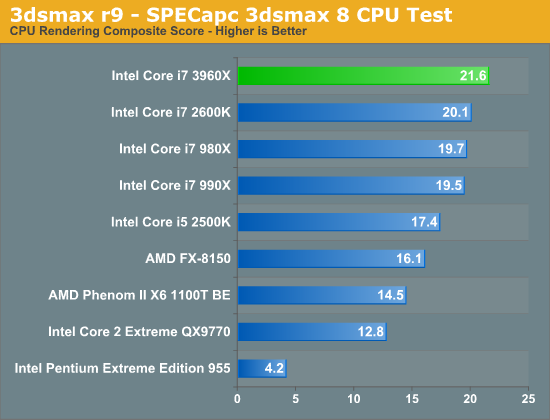
Offline 3D rendering applications make some of the best use of CPU cores, unfortunately our test here doesn't scale all that well. We only see a 7% increase over the 2600K. If we look at a more modern 3D workload however...
Cinebench 11.5
Created by the Cinema 4D folks we have Cinebench, a popular 3D rendering benchmark that gives us both single and multi-threaded 3D rendering results.
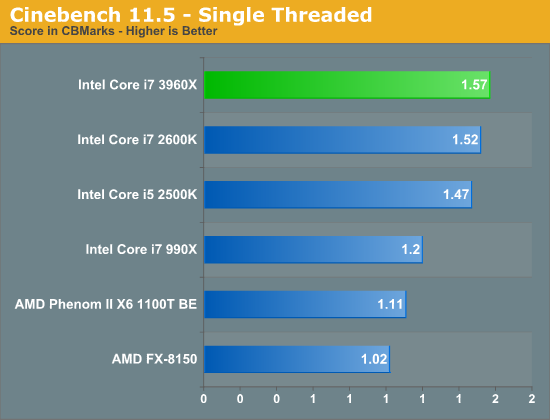
Single threaded performance is marginally better than the 2600K thanks to the 3960X's slightly higher max turbo speed. What's more important than the performance here is the fact that the 3960X is able to properly power gate all idle cores and give a single core full reign of the chip's TDP. Turbo is alive and well in SNB-E, just as it was in Sandy Bridge.
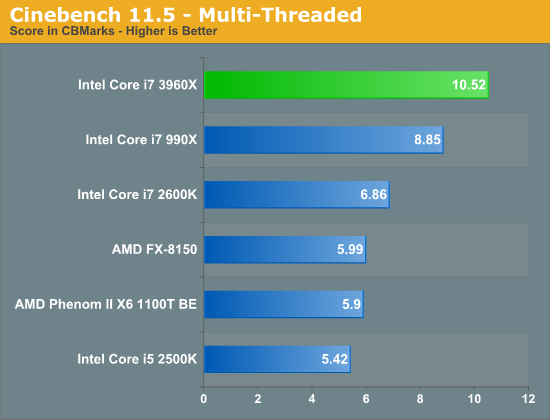
Here the performance gains are staggering. The 3960X is 53% faster than the 2600K and 19% faster than Intel's previous 6-core flagship, the 990X. The Bulldozer comparison is almost unfair, the 3960X is 75% faster (granted it is also multiple times the price of the FX-8150).
7-Zip Benchmark
While Cinebench shows us multithreaded floating point performance, the 7-zip benchmark gives us an indication of multithreaded integer performance:

Here we see huge gains over the 2600K (58%), indicating that the increase in cache size and memory bandwidth help the boost in core count a bit here. The advantage over the 990X is only 7%. This gives us a bit of a preview of what we can expect from SNB-EP Xeon server performance.
PAR2 Benchmark
Par2 is an application used for reconstructing downloaded archives. It can generate parity data from a given archive and later use it to recover the archive
Chuchusoft took the source code of par2cmdline 0.4 and parallelized it using Intel’s Threading Building Blocks 2.1. The result is a version of par2cmdline that can spawn multiple threads to repair par2 archives. For this test we took a 708MB archive, corrupted nearly 60MB of it, and used the multithreaded par2cmdline to recover it. The scores reported are the repair and recover time in seconds.
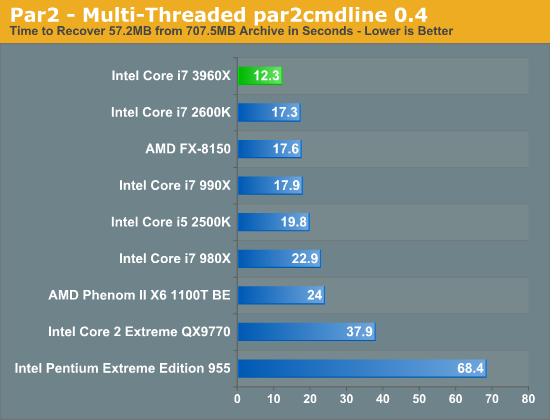
Here we see a 40% increase in performance over the 2600K and FX-8150.
TrueCrypt Benchmark
TrueCrypt is a very popular encryption package that offers full AES-NI support. The application also features a built-in encryption benchmark that we can use to measure CPU performance with:
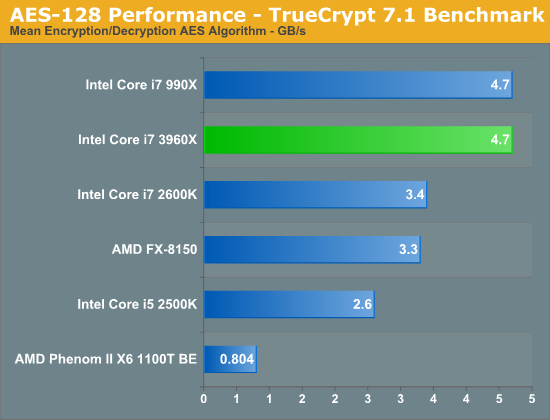
As both the 990X and 3960X have AES-NI support, both are equally capable at cranking through an AES workload. Per core performance doesn't appear to have changed all that much with the move to Sandy Bridge, so here we have a situation where the 3960X is much faster than the 2600K but no faster than the 990X. I suspect these types of scenarios will be fairly rare.
x264 HD 3.03 Benchmark
Graysky's x264 HD test uses x264 to encode a 4Mbps 720p MPEG-2 source. The focus here is on quality rather than speed, thus the benchmark uses a 2-pass encode and reports the average frame rate in each pass.
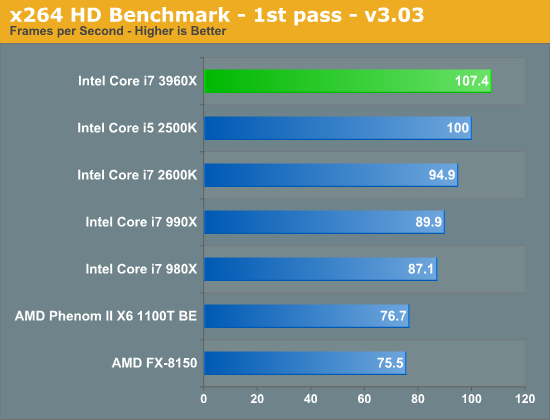
Single threaded performance isn't significantly faster than your run-of-the-mill Sandy Bridge, which means the first x264 HD pass doesn't look all that impressive on SNB-E.
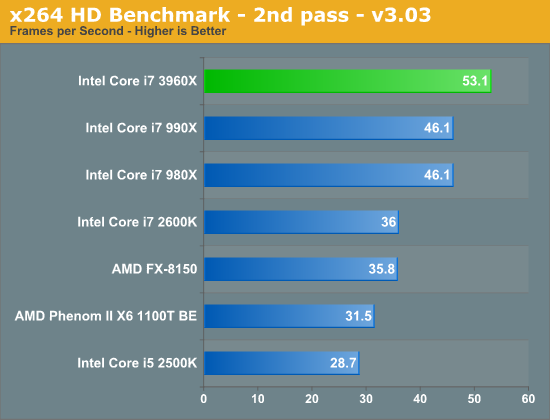
The second pass however stresses all six cores far more readily, resulting in a 47.5% increase in performance over the 2600K. Even compared to the 990X there's a 15% increase in performance.
Adobe Photoshop CS4
To measure performance under Photoshop CS4 we turn to the Retouch Artists’ Speed Test. The test does basic photo editing; there are a couple of color space conversions, many layer creations, color curve adjustment, image and canvas size adjustment, unsharp mask, and finally a gaussian blur performed on the entire image.
The whole process is timed and thanks to the use of Intel's X25-M SSD as our test bed hard drive, performance is far more predictable than back when we used to test on mechanical disks.
Time is reported in seconds and the lower numbers mean better performance. The test is multithreaded and can hit all four cores in a quad-core machine.
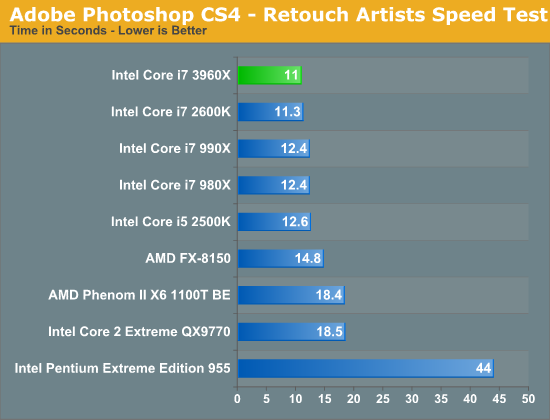
Our Photoshop test is multithreaded but there are only spikes that use more than four cores. That combined with the short duration of the benchmark shows no real advantage to the 3960X over the 2600K. Sandy Bridge E is faster than Intel's old 6-core solution though.
Compile Chromium Test
You guys asked for it and finally I have something I feel is a good software build test. Using Visual Studio 2008 I'm compiling Chromium. It's a pretty huge project that takes over forty minutes to compile from the command line on the Core i3 2100. But the results are repeatable and the compile process will stress all 12 threads at 100% for almost the entire time on a 980X so it works for me.
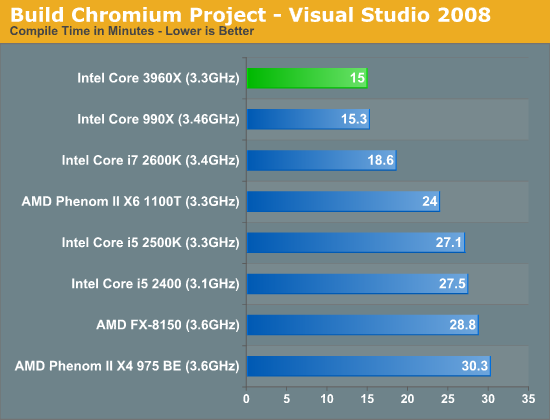
Our compile test is extremely well threaded, which once again does well on the 3960X. The gains aren't as big as what we saw in some of our earlier 3D/transcoding tests, but if you're looking to build the fastest development workstation you'll want a Sandy Bridge E.
Excel Monte Carlo
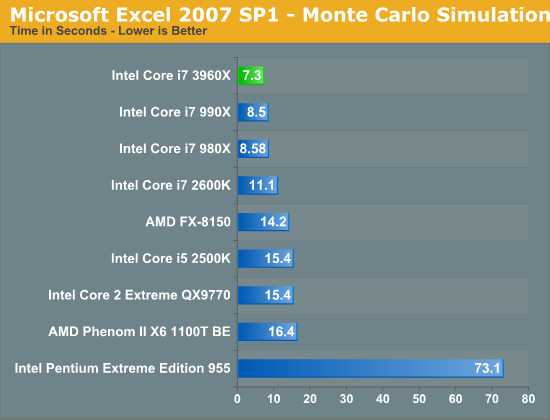
Multithreaded compute does well on SNB-E regardless of the type of application. Excel is multithreaded and if you have a beefy enough workload, you'll see huge gains over the 2600K.










163 Comments
View All Comments
mcturkey - Monday, November 14, 2011 - link
Glad I'm not the only one who was thinking that! My 486 66 only had 4MB as well.Anand Lal Shimpi - Monday, November 14, 2011 - link
My 386 started with 4MB, but I kept it for a very long time as upgrading was fairly expensive. I eventually threw a ton of memory at it as my last upgrade to the platform :)Take care,
Anand
BSMonitor - Monday, November 14, 2011 - link
How big was your 386's hard drive?How many times over could you store it's entire contents in 8 DIMM's of DDR3 memory, now ?? And for probably less cost!
Thought I saw a 16GB kit on newegg for $75? Lol!
just4U - Monday, November 14, 2011 - link
I had a roomie 81 meg harddrive in my 386/16khanov - Monday, November 14, 2011 - link
"With the socket the same, is the reviewed SB-E the same design as the new Xeons? Will there be 3D design like Ivy Bridge?"1. It is the exact same die as the new Xeons, although of course different parts are harvested for each market.
2. Yes there will be a 3D transistor design (according to rumors) but this will be Ivy Bridge-E and will not launch until at least late 2012.
gamoniac - Monday, November 14, 2011 - link
Anand,More and more power users are running VMs on their desktops or workstation. With most Intel and AMD CPU now support Intel-VT or AMD-V, I notice a lack of measurement in this department in pretty much all online reviews. When you update your test suite, could you possibly include some sort VM test? Note: If so, could you possibly run the VM test on SSD to eliminate HDD limitation?
Thanks for the great review and conclusion, as always.
Senti - Monday, November 14, 2011 - link
I'm amazed how much fuss QuickSync is still generating in reviews. Let's face it - it's fairly useless in current state. Cool words "GPU video transcoding" can only impress casual users, not someone who cares about quality in first place and speed only after that.With time it will be even more useless if like GPU video decoding it's unable to work with 10 bit and 422/444 content (very likely).
gunslinger5577 - Monday, November 14, 2011 - link
This review indicates no significant improvement with 2x 16x PCI-E lanes in SLI. However the ASUS X79 Pro MB review seems to indicate there is a measurable and significant at times advantage.fishbits - Monday, November 14, 2011 - link
Weird stuff. Why fret over on-die USB 3.0 when every mobo supports it? And mourning Quick Sync for a CPU that flies at encoding without it? Or when you'd already have an SNB with Quick Sync? Really unhappy with the new Porche's glove compartment...Love the CPU/Platform, but too pricey for how much I'd use it over what's currently available. Hoping against hope that mainstream Ivy offers 8 RAM slots, but not holding my breath.
DanNeely - Monday, November 14, 2011 - link
Each addon chip the mobo makers include increases the cost of the board (not just the chip itself, but the engineering time needed to integrate it, and potentially (if enough are chips are added) by adding an extra layer to the PCB).You also take a hit in the number of PCIe lanes available for expansion slots. With legacy PCI gone from the southbridge we're unlikely to see any 4x electrical slots coming off of it. Audio, ethernet, and firewire, will take 1 lane each; USB3 controllers will take 1lane/2 ports, probably 3lanes total/board leaving only 2 for expansion slots. THe main impact here is just not being able to go all USB3 for the legacy free gloss without a major squeeze elsewhere. Scientific customers doing stuff that actually needs the PCE 3.0 bandwidth without needing 2x width cards could end up being dinged since it means several fewer total lanes for them to hook stuff up to.